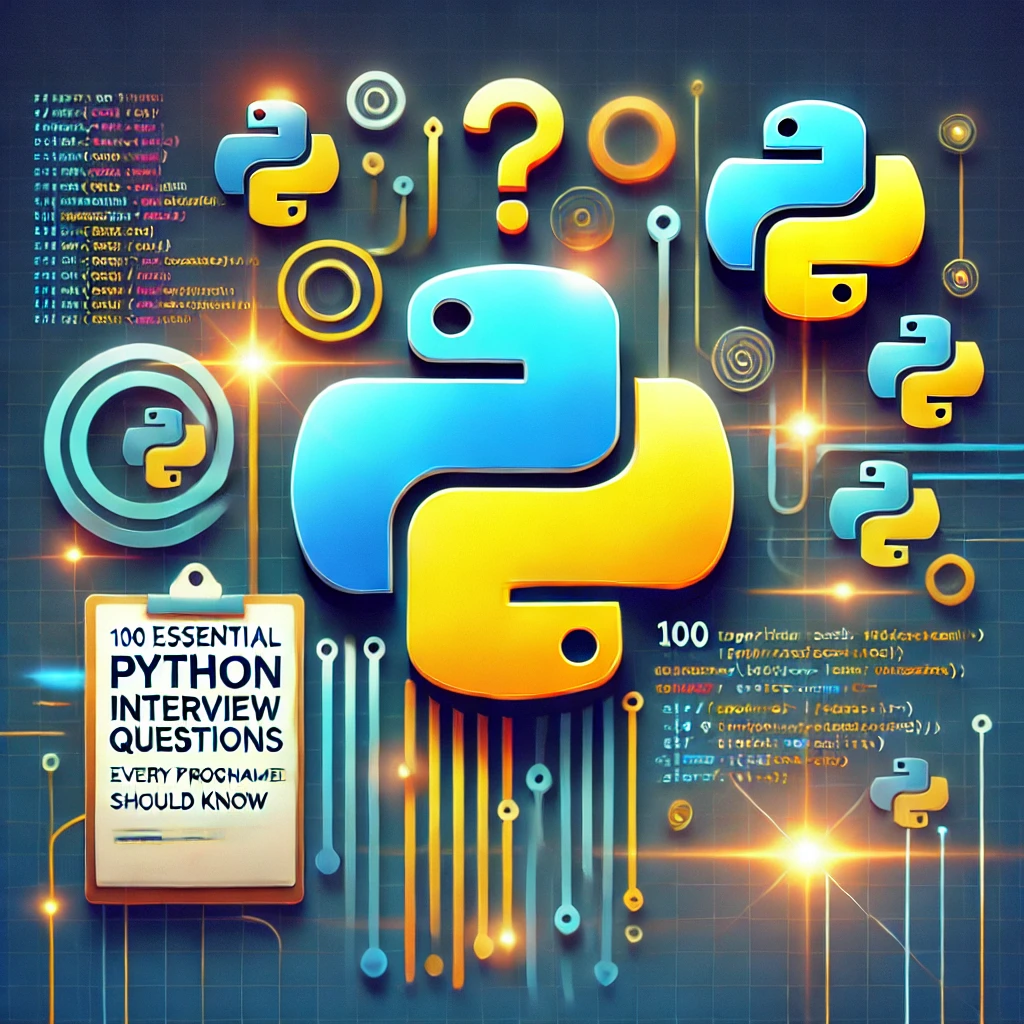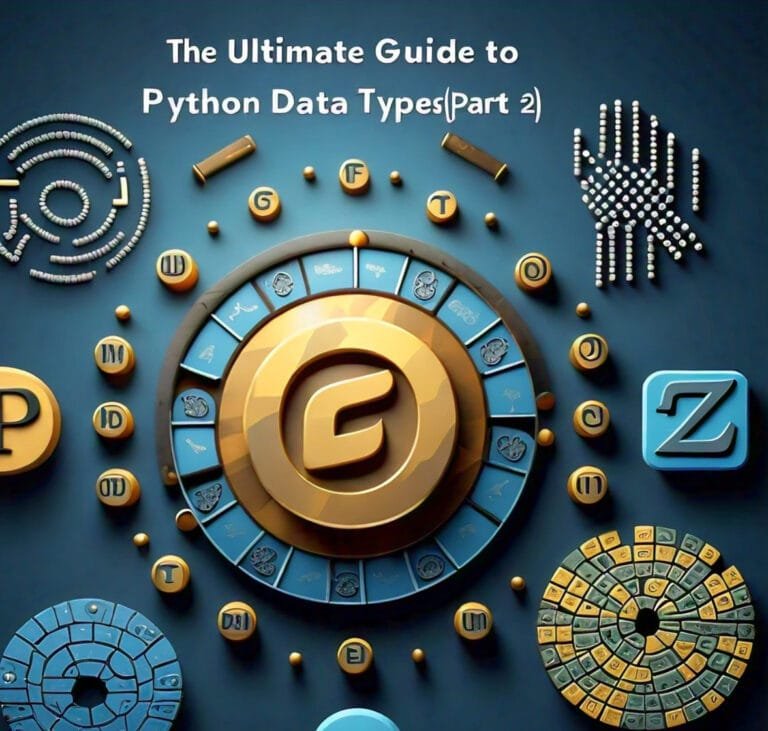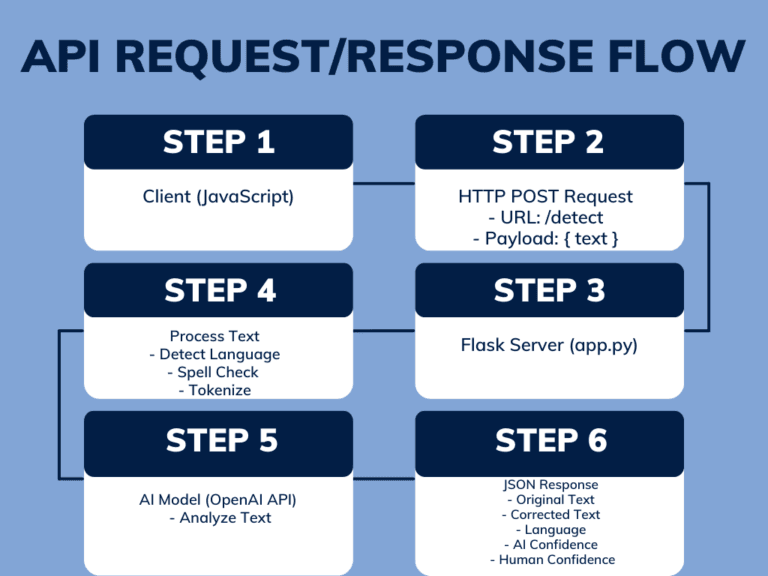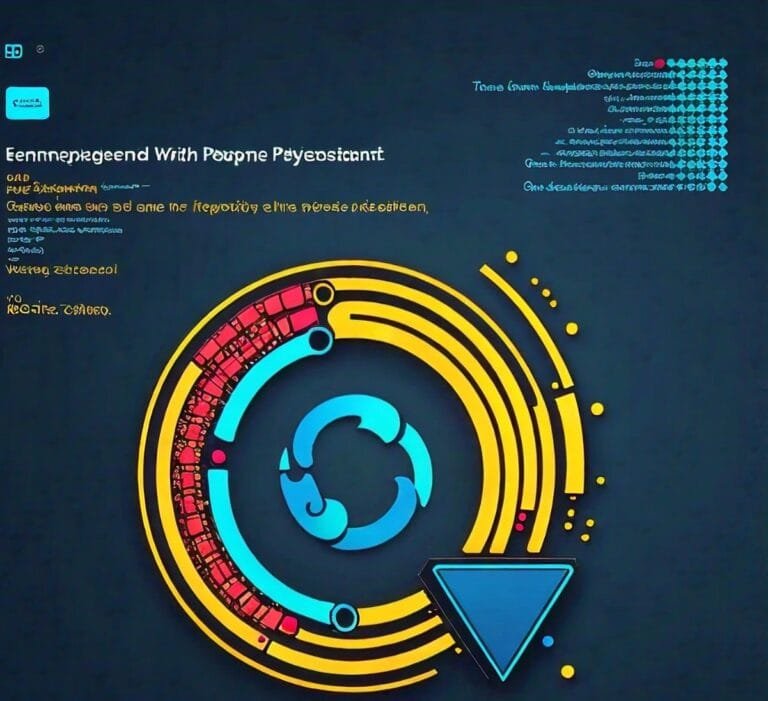100 Essential Python Interview Questions Every Programmer Should Know
Introduction to Python Interview Questions
In today’s tech landscape, Python has become one of the most popular programming languages. It is essential for success in fields like web development, data science, machine learning, and automation. Preparing for job interviews requires a solid grasp of Python concepts. Employers seek candidates who not only write code but also demonstrate a deep understanding of the language. To help you with this, we’ve compiled 100 Essential Python Interview Questions Every Programmer Should Know.
This guide covers a wide range of topics. You’ll find questions about fundamental syntax, data structures, and advanced concepts like decorators and generators. Each question aims to test your knowledge and build your confidence for your next interview.
Whether you’re getting ready for a technical interview at a leading tech company or brushing up on your skills for personal growth, these questions will be valuable. Let’s dive in and equip you with the insights you need to ace your Python interviews!

Tips on how to approach tricky Python challenges in interviews
Here are some tips on how to approach tricky Python challenges during interviews that can help you stay calm and tackle complex problems efficiently:
1. Understand the Problem First
- Don’t rush into coding. Make sure you fully understand the problem first. Read the question carefully and, if needed, clarify any doubts with the interviewer.
- Break down the problem into smaller parts and identify the inputs, outputs, and any constraints.
2. Think Out Loud
- Communicate your thought process with the interviewer. Walk them through how you plan to approach the problem, even before typing out the solution.
- This not only helps you organize your thoughts but also gives interviewers insight into your problem-solving approach.
3. Start with a Naive Solution
- If the optimal solution isn’t immediately clear, start with a simple or brute-force approach. It shows that you can solve the problem even if it’s not the most efficient solution.
- Once you have a basic solution, you can begin optimizing it.
4. Break It Down
- Break the problem into smaller functions or components. This helps in making your code more modular and easy to debug.
- If you hit a roadblock, it’s easier to debug smaller sections than one large piece of code.
5. Use Pythonic Features
- Take advantage of Python’s built-in features like list comprehensions,
zip(),map(),filter(), and other utility functions that can simplify your code. - Using standard libraries (e.g.,
collections,itertools, orfunctools) can often help in crafting an elegant solution.
6. Watch Out for Edge Cases
- Interviewers often test your solution against edge cases (e.g., empty input, very large numbers, or unusual inputs). Try to think of edge cases as you write your code and handle them explicitly.
- Test your solution with edge case examples before you present it as final.
7. Time and Space Complexity
- After solving the problem, explain the time complexity (Big O) and space complexity of your solution. This shows that you are aware of how efficient your code is and can improve it if necessary.
- Consider trade-offs between time and space, and discuss possible optimizations.
8. Optimize When Necessary
- If there’s time after solving the problem, discuss how you could improve the solution (e.g., reducing time complexity from O(n^2) to O(n log n)).
- Look for common optimization techniques like using hashmaps for faster lookups or memoization to avoid redundant calculations.
9. Stay Calm Under Pressure
- Even if you’re stuck, stay calm and don’t panic. Interviewers are often more interested in your problem-solving process than whether you get the perfect answer immediately.
- Take a step back, analyze your approach, and if necessary, ask for hints. This shows you’re willing to adapt and collaborate.
10. Practice, Practice, Practice
- Regularly practice coding problems on platforms like LeetCode, HackerRank, or Codewars. Focus on solving a variety of Python problems, including easy, medium, and hard levels.
- Familiarity with common patterns (e.g., sliding window, dynamic programming, recursion) will help you recognize solutions faster during interviews.
Basic Python Interview Questions
1. What is Python?
Answer: Python is a high-level, interpreted programming language known for its readability and simplicity. It supports multiple programming paradigms, including procedural, object-oriented, and functional programming.
2. What are Python’s built-in data types?
Answer: Python has several built-in data types, including:
Numeric Types: int, float, complex
Sequence Types: list, tuple, range
Text Type: str
Mapping Type: dict
Set Types: set, frozenset
Boolean Type: bool
Binary Types: bytes, bytearray, memoryview
3. How do you comment in Python?
Answer: You can comment in Python using the # symbol for single-line comments or triple quotes (''' or """) for multi-line comments.
4. What is a list in Python?
Answer: A list is an ordered, mutable collection of items. Lists can contain elements of different data types and can be modified after creation.
5. What is a tuple?
Answer: A tuple is similar to a list, but it is immutable. Once created, you cannot change the elements of a tuple. Tuples are defined using parentheses ().
6. What is a dictionary?
Answer: A dictionary is an unordered collection of key-value pairs. Each key must be unique and is used to access its corresponding value. Dictionaries are defined using curly braces {}.
7. What is a set?
Answer: A set is an unordered collection of unique elements. It is defined using curly braces {} or the set() constructor.
8. What are the different ways to create a list?
Answer:
Square brackets: my_list = [1, 2, 3]
Using the list() constructor: my_list = list((1, 2, 3))
Using list comprehension: my_list = [x for x in range(5)]
9. How do you find the length of a list?
Answer: You can find the length of a list using the len() function. For example: len(my_list).
10. What are the key differences between append() and extend() methods in lists?
Answer:
append(): Adds a single element to the end of the list.
extend(): Adds multiple elements (from an iterable) to the end of the list.
Intermediate Python Interview Questions
11. What is the difference between is and == in Python?
Answer: is checks for object identity (whether two variables point to the same object), while == checks for value equality (whether the values of two objects are the same).
12. How do you handle exceptions in Python?
Answer: Exceptions can be handled using the try, except, else, and finally blocks. For example:
try:
# code that may raise an exception
except SomeException:
# handle exception
13. What are Python decorators?
- Answer: Decorators are functions that modify the behavior of another function. They are often used for logging, enforcing access control, or modifying input/output.
14. Explain list comprehension and provide an example.
- Answer: List comprehension is a concise way to create lists. For example
squares = [x ** 2 for x in range(10)]
15. What is the purpose of the pass statement in Python?
- Answer: The
passstatement is a null operation that acts as a placeholder. It can be used in places where syntactically some code is required but you do not want to execute any command.
16. What are modules and packages in Python?
- Answer: A module is a file containing Python code that can be imported and reused. A package is a collection of modules organized in a directory hierarchy and can contain sub-packages.
17. What is the purpose of the self keyword in Python?
- Answer: The
selfkeyword refers to the instance of the class. It is used to access variables that belong to the class and is the first parameter of instance methods.
18. What are Python iterators?
- Answer: An iterator is an object that implements the iterator protocol, which consists of the
__iter__()and__next__()methods. It allows iteration over a collection (like lists, tuples, etc.) without needing to use an index.
19. What is a generator?
- Answer: A generator is a special type of iterator that is defined using a function with the
yieldstatement. It produces values one at a time and maintains state between calls.
20. How do you sort a list in Python?
- Answer: You can sort a list in place using the
sort()method or create a new sorted list using thesorted()function. For example:
my_list.sort() # In-place sorting
sorted_list = sorted(my_list) # New sorted list
Advanced Python Interview Questions
21. What is the Global Interpreter Lock (GIL)?
Answer: The GIL is a mutex that protects access to Python objects, preventing multiple threads from executing Python bytecodes simultaneously. This can be a limitation for CPU-bound threads but allows I/O-bound threads to run concurrently.
22. How do you implement a binary search algorithm in Python?
Answer:
def binary_search(arr, target):
low, high = 0, len(arr) - 1
while low <= high:
mid = (low + high) // 2
if arr[mid] < target:
low = mid + 1
elif arr[mid] > target:
high = mid - 1
else:
return mid
return -1
23. What is the difference between shallow copy and deep copy?
- Answer: A shallow copy creates a new object but inserts references into it to the objects found in the original. A deep copy creates a new object and recursively adds copies of nested objects found in the original.
24. How can you reverse a string in Python?
- Answer: You can reverse a string using slicing
reversed_string = original_string[::-1]
25. How do you check if a string is a palindrome?
- Answer:
def is_palindrome(s):
return s == s[::-1]
26. **What are *args and kwargs?
- Answer:
*argsallows a function to accept any number of positional arguments as a tuple, while**kwargsallows a function to accept any number of keyword arguments as a dictionary.
27. What is the difference between Python 2 and Python 3?
- Answer: Key differences include:
printis a function in Python 3 (e.g.,print("Hello")).- Integer division in Python 3 returns a float (e.g.,
5 / 2gives2.5). - Python 3 supports Unicode by default for strings.
28. How do you remove duplicates from a list?
- Answer: You can remove duplicates by converting the list to a set and back to a list:
unique_list = list(set(my_list))
29. What is the purpose of the with statement in Python?
- Answer: The
withstatement simplifies exception handling by encapsulating common preparation and cleanup tasks in a context manager, often used for managing resources like file streams.
30. How do you perform a linear search in Python?
- Answer
def linear_search(arr, target):
for index, value in enumerate(arr):
if value == target:
return index
return -1
Python Interview Questions – Data Structures and Algorithms
31. How do you find the factorial of a number in Python?
Answer:
def factorial(n):
if n == 0:
return 1
else:
return n * factorial(n - 1)
32. What is a stack? How can you implement one in Python?
- Answer: A stack is a data structure that follows the Last In First Out (LIFO) principle. It can be implemented using a list:
stack = []
stack.append(1) # Push
stack.pop() # Pop
33. What is a queue? How can you implement one in Python?
- Answer: A queue is a data structure that follows the First In First Out (FIFO) principle. It can be implemented using
collections.deque:
from collections import deque
queue = deque()
queue.append(1) # Enqueue
queue.popleft() # Dequeue
34. How do you check for balanced parentheses in an expression?
- Answer:
def is_balanced(expression):
stack = []
pairs = {')': '(', '}': '{', ']': '['}
for char in expression:
if char in pairs.values():
stack.append(char)
elif char in pairs.keys():
if stack == [] or pairs[char] != stack.pop():
return False
return stack == []
35. What is a binary tree? How do you traverse it?
- Answer: A binary tree is a tree data structure where each node has at most two children. Traversal methods include:
- In-order: Left, Root, Right
- Pre-order: Root, Left, Right
- Post-order: Left, Right, Root
36. What is a linked list? How do you implement it?
- Answer: A linked list is a linear data structure where elements are stored in nodes, and each node points to the next. Here’s a simple implementation:
class Node:
def __init__(self, data):
self.data = data
self.next = None
class LinkedList:
def __init__(self):
self.head = None
37. How do you implement a hash table in Python?
- Answer: Python has built-in support for hash tables through dictionaries. You can create one like this:
my_dict = {}
my_dict["key"] = "value"
38. What is a heap? How do you implement a min-heap?
- Answer: A heap is a special tree-based data structure that satisfies the heap property. You can use the
heapqmodule for a min-heap:
import heapq
heap = []
heapq.heappush(heap, 1) # Push
smallest = heapq.heappop(heap) # Pop smallest element
39. How do you find the maximum and minimum values in a list?
- Answer: You can use the built-in
max()andmin()functions
max_value = max(my_list)
min_value = min(my_list)
40. How do you implement a sorting algorithm (e.g., bubble sort) in Python?
- Answer
def bubble_sort(arr):
n = len(arr)
for i in range(n):
for j in range(0, n-i-1):
if arr[j] > arr[j+1]:
arr[j], arr[j+1] = arr[j+1], arr[j]
Python Interview Questions based on Libraries and Frameworks
41. What is NumPy?
Answer: NumPy is a powerful library for numerical computing in Python. It provides support for arrays, matrices, and mathematical functions.
42. How do you create a NumPy array?
Answer:
import numpy as np
array = np.array([1, 2, 3, 4])
43. What is Pandas?
- Answer: Pandas is a library for data manipulation and analysis. It provides data structures like Series and DataFrame to handle structured data.
44. How do you read a CSV file using Pandas?
- Answer
import pandas as pd
df = pd.read_csv('file.csv')
45. What is Matplotlib?
Answer: Matplotlib is a plotting library for Python that allows you to create static, animated, and interactive visualizations.
46. How do you plot a simple line graph using Matplotlib?
- Answer:
import matplotlib.pyplot as plt
plt.plot([1, 2, 3], [4, 5, 6])
plt.show()
47. What is Scikit-learn?
- Answer: Scikit-learn is a machine learning library in Python that provides simple and efficient tools for data mining and data analysis.
48. How do you fit a linear regression model using Scikit-learn?
- Answer:
from sklearn.linear_model import LinearRegression
model = LinearRegression()
model.fit(X, y)
49. What is TensorFlow?
- Answer: TensorFlow is an open-source deep learning framework developed by Google that provides a flexible ecosystem of tools and libraries for building machine learning models.
50. How do you create a simple neural network using Keras?
- Answer
from tensorflow.keras.models import Sequential
from tensorflow.keras.layers import Dense
model = Sequential()
model.add(Dense(32, activation='relu', input_shape=(input_dim,)))
model.add(Dense(1, activation='sigmoid'))
model.compile(optimizer='adam', loss='binary_crossentropy', metrics=['accuracy'])
Object-Oriented Programming – Python Interview Questions
51. What is object-oriented programming (OOP)?
Answer: OOP is a programming paradigm based on the concept of “objects,” which can contain data (attributes) and code (methods). It promotes encapsulation, inheritance, and polymorphism.
52. What are the four pillars of OOP?
Answer: The four pillars of OOP are:
Encapsulation: Bundling data and methods into a single unit or class.
Abstraction: Hiding complex implementation details and showing only essential features.
Inheritance: Deriving new classes from existing ones, inheriting attributes and methods.
Polymorphism: The ability to present the same interface for different data types.
53. How do you create a class in Python?
Answer
class MyClass:
def __init__(self, value):
self.value = value
def display(self):
print(self.value)
54. What is inheritance?
- Answer: Inheritance allows a class to inherit attributes and methods from another class, promoting code reusability. It is defined using the following syntax:
class ChildClass(ParentClass):
pass
55. What is polymorphism?
- Answer: Polymorphism allows methods to be defined in different classes with the same name but different implementations. It can be achieved through method overriding and method overloading.
56. What is encapsulation?
- Answer: Encapsulation is the bundling of data (attributes) and methods (functions) that operate on the data within a single unit or class, restricting direct access to some of the object’s components.
57. How do you override a method in a subclass?
- Answer: You can override a method by defining a method with the same name in the subclass:
class Parent:
def display(self):
print("Parent")
class Child(Parent):
def display(self):
print("Child")
58. What is the super() function?
- Answer: The
super()function returns a temporary object of the superclass that allows access to its methods and properties. It is commonly used to call a method from the parent class in a subclass.
59. How do you create an abstract class in Python?
- Answer: An abstract class can be created using the
abcmodule. You define methods using the@abstractmethoddecorator:
from abc import ABC, abstractmethod
class MyAbstractClass(ABC):
@abstractmethod
def my_method(self):
pass
60. What is multiple inheritance?
Answer: Multiple inheritance allows a class to inherit from more than one parent class. This can lead to the “Diamond Problem,” which is resolved using the Method Resolution Order (MRO) in Python.
Miscellaneous of Python Interview Questions
61. What are lambda functions?
Answer: Lambda functions are small anonymous functions defined with the lambda keyword. They can take any number of arguments but can have only one expression:
add = lambda x, y: x + y
62. What is the difference between a shallow copy and a deep copy?
- Answer: A shallow copy creates a new object but inserts references into it to the objects found in the original. A deep copy creates a new object and recursively adds copies of nested objects found in the original.
63. What is a Python package?
- Answer: A Python package is a way of organizing related Python modules into a directory hierarchy, making it easier to manage and distribute code. Packages must contain an
__init__.pyfile.
64. How do you create a virtual environment in Python?
- Answer: You can create a virtual environment using the
venvmodule
python -m venv myenv
65. How do you activate a virtual environment?
- Answer:
- On Windows:
myenv\Scripts\activate - On macOS/Linux:
source myenv/bin/activate
- On Windows:
66. What is the purpose of __init__.py?
- Answer: The
__init__.pyfile is used to mark a directory as a Python package and can also execute initialization code for the package.
67. What are decorators in Python?
- Answer: Decorators are functions that modify the behavior of another function. They are often used for logging, access control, and other cross-cutting concerns:
def decorator_function(original_function):
def wrapper_function():
print("Wrapper executed before {}".format(original_function.__name__))
return original_function()
return wrapper_function
68. What is exception handling?
- Answer: Exception handling is a mechanism to handle errors gracefully. In Python, you use
try,except, andfinallyblocks:
try:
# Code that may raise an exception
except ExceptionType:
# Code to handle the exception
finally:
# Code that executes regardless of exception
69. What is a context manager?
- Answer: A context manager is a Python object that defines the runtime context to be established when executing a
withstatement. It is commonly used for resource management, like file operations:
with open('file.txt', 'r') as file:
data = file.read()
70. What are the built-in data types in Python?
Answer: Python’s built-in data types include:
Numeric Types: int, float, complex
Sequence Types: list, tuple, range
Text Type: str
Binary Types: bytes, bytearray, memoryview
Set Types: set, frozenset
Mapping Type: dict
Advanced Topics of Python Interview Questions
71. What are generators in Python?
Answer: Generators are iterators that yield values one at a time, using the yield statement. They allow for lazy evaluation:
def my_generator():
yield 1
yield 2
yield 3
72. What is list comprehension?
- Answer: List comprehension is a concise way to create lists by iterating over an iterable and optionally applying a condition:
squares = [x**2 for x in range(10)]
73. What is multithreading?
- Answer: Multithreading is a programming technique that allows concurrent execution of threads within a single process. It is used to improve performance by running tasks in parallel.
74. How do you create a thread in Python?
- Answer:
import threading
def thread_function():
print("Thread is running")
thread = threading.Thread(target=thread_function)
thread.start()
75. What is the Global Interpreter Lock (GIL)?
- Answer: The GIL is a mutex that protects access to Python objects, preventing multiple threads from executing Python bytecode simultaneously. It can be a limitation in CPU-bound multi-threaded programs.
76. What is multiprocessing?
- Answer: Multiprocessing is a technique that allows the execution of multiple processes simultaneously, each with its own Python interpreter and memory space. It can bypass the GIL limitation.
77. How do you create a process in Python?
- Answer
from multiprocessing import Process
def process_function():
print("Process is running")
process = Process(target=process_function)
process.start()
78. What is the difference between threading and multiprocessing?
Answer: Threading involves multiple threads within the same process sharing memory, while multiprocessing involves multiple processes, each with its own memory space. Multiprocessing is generally better for CPU-bound tasks.
79. What are Python modules?
Answer: A Python module is a file containing Python code (functions, classes, variables) that can be imported and used in other Python scripts. Modules promote code reuse and organization.
80. What is the difference between a module and a package?
Answer: A module is a single file containing Python code, while a package is a directory that contains multiple modules along with an __init__.py file.
Python Interview Questions for Data Science and Machine Learning
81. What is supervised learning?
Answer: Supervised learning is a type of machine learning where a model is trained on labeled data, meaning that both input features and corresponding output labels are provided.
82. What is unsupervised learning?
Answer: Unsupervised learning involves training a model on data without labeled responses. The model tries to identify patterns and relationships within the data.
83. What is reinforcement learning?
Answer: Reinforcement learning is a type of machine learning where an agent learns to make decisions by taking actions in an environment to maximize cumulative rewards.
84. What is a confusion matrix?
Answer: A confusion matrix is a table used to evaluate the performance of a classification model. It summarizes the true positives, true negatives, false positives, and false negatives.
85. What is overfitting in machine learning?
Answer: Overfitting occurs when a machine learning model learns the training data too well, capturing noise and outliers, resulting in poor performance on unseen data.
86. What is cross-validation?
Answer: Cross-validation is a technique used to assess how the results of a statistical analysis will generalize to an independent dataset. It involves partitioning the data into subsets to validate the model.
87. What is feature engineering?
Answer: Feature engineering is the process of selecting, modifying, or creating new features from raw data to improve the performance of machine learning models.
88. What is a hyperparameter?
Answer: A hyperparameter is a parameter whose value is set before the learning process begins. Examples include learning rate, number of trees in a random forest, and the number of hidden layers in a neural network.
89. What is a decision tree?
Answer: A decision tree is a flowchart-like tree structure used for classification and regression tasks. Each internal node represents a feature (attribute), each branch represents a decision rule, and each leaf node represents an outcome.
90. What is ensemble learning?
Answer: Ensemble learning is a technique that combines multiple models to produce better predictions. Examples include bagging (e.g., Random Forest) and boosting (e.g., AdaBoost, Gradient Boosting).
Final Questions on Python Interview Questions
91. What are Python’s built-in functions?
Answer: Python provides many built-in functions, including print(), len(), sum(), max(), min(), range(), and more.
92. What is list slicing?
Answer: List slicing allows you to access a portion of a list by specifying a start and end index:
my_list = [1, 2, 3, 4, 5]
slice = my_list[1:4] # Output: [2, 3, 4]
93. How do you concatenate two lists?
- Answer: You can concatenate two lists using the
+operator
list1 = [1, 2, 3]
list2 = [4, 5, 6]
combined = list1 + list2 # Output: [1, 2, 3, 4, 5, 6]
94. What is a Python iterator?
- Answer: An iterator is an object that implements the iterator protocol, consisting of the
__iter__()and__next__()methods, allowing traversal of a container, such as a list or tuple.
95. What is the difference between == and is?
- Answer: The
==operator checks for value equality, while theisoperator checks for identity (whether two references point to the same object in memory).
96. How do you handle exceptions in Python?
- Answer: Exceptions can be handled using
try,except, andfinallyblocks to catch and manage errors gracefully.
97. What are positional arguments?
- Answer: Positional arguments are arguments passed to a function in the correct order, corresponding to the parameters defined in the function’s signature.
98. What are keyword arguments?
- Answer: Keyword arguments are arguments passed to a function by explicitly specifying the parameter names, allowing you to provide them in any order.
99. What is the purpose of the pass statement?
- Answer: The
passstatement is a no-operation statement that serves as a placeholder in loops, functions, or classes where syntactically some code is required but you do not want to execute any action.
100. How do you check the data type of a variable?
Answer: You can use the type() function to check the data type of a variable: python my_variable = 10 print(type(my_variable)) # Output: <class 'int'>
Conclusion on Python Interview Questions
Mastering Python is key to standing out in technical interviews, especially with top companies. By familiarizing yourself with these 100 essential Python interview questions, you’ll be better prepared to tackle various coding challenges and demonstrate your expertise. Whether you’re revisiting core concepts or sharpening your skills in advanced topics, this guide offers valuable insights to help you succeed. Remember, practice and understanding are the keys to acing any interview—so keep learning, stay confident, and good luck!
External Resources on Python Interview Questions
- The official Python documentation is a must-visit resource for understanding Python’s core features, standard libraries, and best practices.
- LeetCode offers a wide variety of Python coding challenges frequently asked in technical interviews at top tech companies.








Leave a Reply